sensor FORD TAURUS 2018 Workshop Manual
[x] Cancel search | Manufacturer: FORD, Model Year: 2018, Model line: TAURUS, Model: FORD TAURUS 2018Pages: 510, PDF Size: 22.04 MB
Page 290 of 510
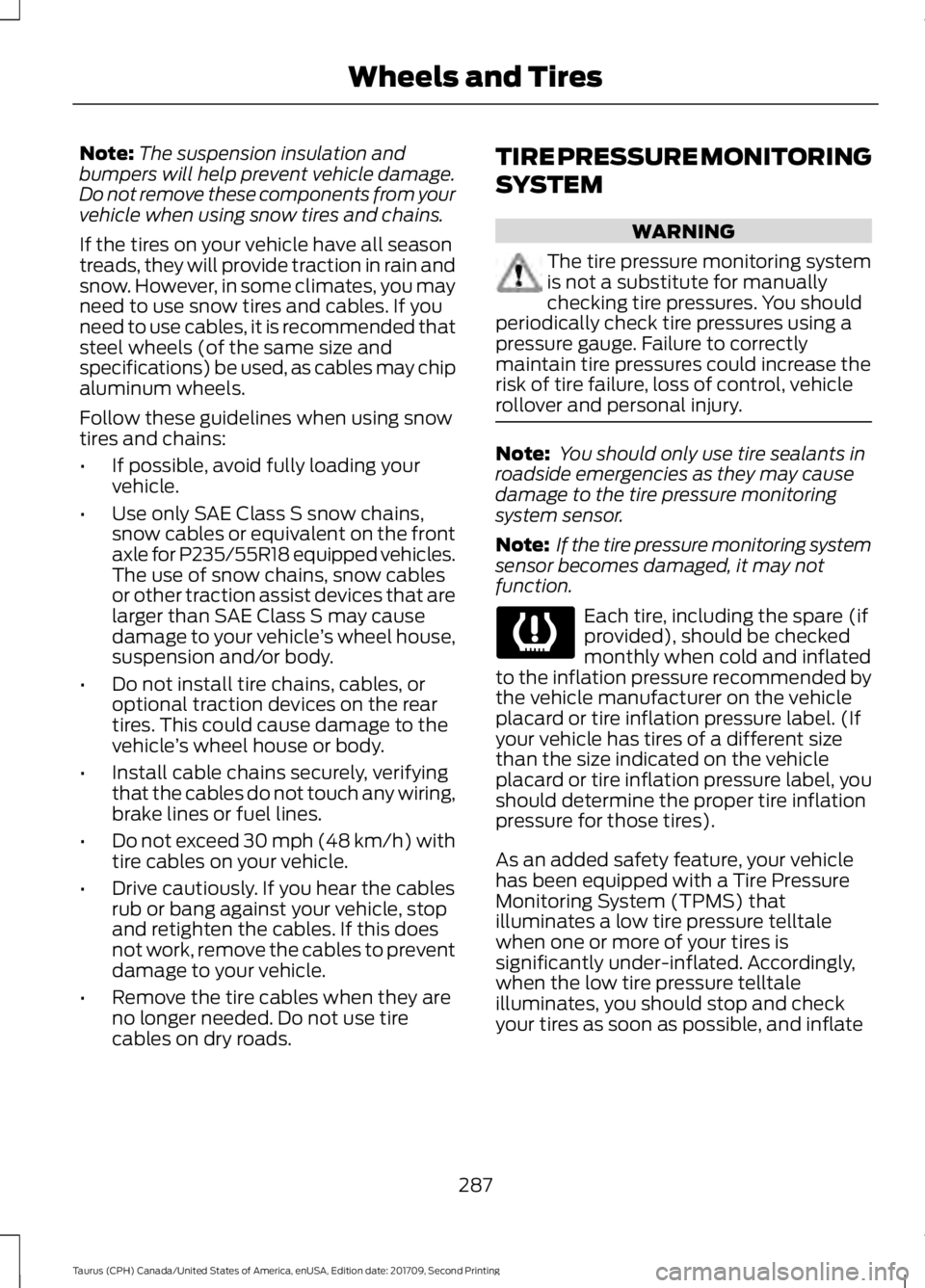
Note:
The suspension insulation and
bumpers will help prevent vehicle damage.
Do not remove these components from your
vehicle when using snow tires and chains.
If the tires on your vehicle have all season
treads, they will provide traction in rain and
snow. However, in some climates, you may
need to use snow tires and cables. If you
need to use cables, it is recommended that
steel wheels (of the same size and
specifications) be used, as cables may chip
aluminum wheels.
Follow these guidelines when using snow
tires and chains:
• If possible, avoid fully loading your
vehicle.
• Use only SAE Class S snow chains,
snow cables or equivalent on the front
axle for P235/55R18 equipped vehicles.
The use of snow chains, snow cables
or other traction assist devices that are
larger than SAE Class S may cause
damage to your vehicle ’s wheel house,
suspension and/or body.
• Do not install tire chains, cables, or
optional traction devices on the rear
tires. This could cause damage to the
vehicle ’s wheel house or body.
• Install cable chains securely, verifying
that the cables do not touch any wiring,
brake lines or fuel lines.
• Do not exceed 30 mph (48 km/h) with
tire cables on your vehicle.
• Drive cautiously. If you hear the cables
rub or bang against your vehicle, stop
and retighten the cables. If this does
not work, remove the cables to prevent
damage to your vehicle.
• Remove the tire cables when they are
no longer needed. Do not use tire
cables on dry roads. TIRE PRESSURE MONITORING
SYSTEM WARNING
The tire pressure monitoring system
is not a substitute for manually
checking tire pressures. You should
periodically check tire pressures using a
pressure gauge. Failure to correctly
maintain tire pressures could increase the
risk of tire failure, loss of control, vehicle
rollover and personal injury. Note:
You should only use tire sealants in
roadside emergencies as they may cause
damage to the tire pressure monitoring
system sensor.
Note: If the tire pressure monitoring system
sensor becomes damaged, it may not
function. Each tire, including the spare (if
provided), should be checked
monthly when cold and inflated
to the inflation pressure recommended by
the vehicle manufacturer on the vehicle
placard or tire inflation pressure label. (If
your vehicle has tires of a different size
than the size indicated on the vehicle
placard or tire inflation pressure label, you
should determine the proper tire inflation
pressure for those tires).
As an added safety feature, your vehicle
has been equipped with a Tire Pressure
Monitoring System (TPMS) that
illuminates a low tire pressure telltale
when one or more of your tires is
significantly under-inflated. Accordingly,
when the low tire pressure telltale
illuminates, you should stop and check
your tires as soon as possible, and inflate
287
Taurus (CPH) Canada/United States of America, enUSA, Edition date: 201709, Second Printing Wheels and Tires
Page 291 of 510
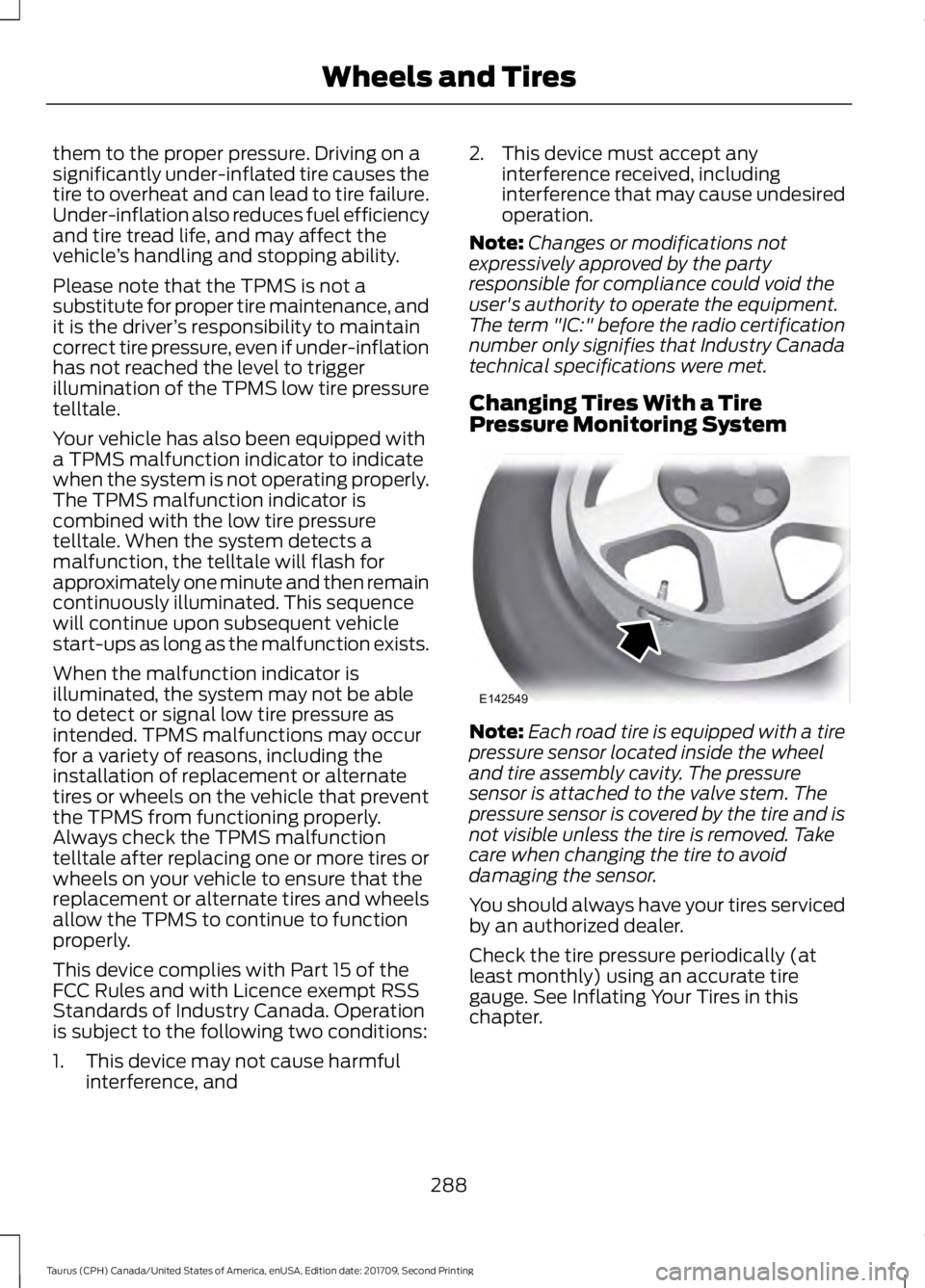
them to the proper pressure. Driving on a
significantly under-inflated tire causes the
tire to overheat and can lead to tire failure.
Under-inflation also reduces fuel efficiency
and tire tread life, and may affect the
vehicle
’s handling and stopping ability.
Please note that the TPMS is not a
substitute for proper tire maintenance, and
it is the driver ’s responsibility to maintain
correct tire pressure, even if under-inflation
has not reached the level to trigger
illumination of the TPMS low tire pressure
telltale.
Your vehicle has also been equipped with
a TPMS malfunction indicator to indicate
when the system is not operating properly.
The TPMS malfunction indicator is
combined with the low tire pressure
telltale. When the system detects a
malfunction, the telltale will flash for
approximately one minute and then remain
continuously illuminated. This sequence
will continue upon subsequent vehicle
start-ups as long as the malfunction exists.
When the malfunction indicator is
illuminated, the system may not be able
to detect or signal low tire pressure as
intended. TPMS malfunctions may occur
for a variety of reasons, including the
installation of replacement or alternate
tires or wheels on the vehicle that prevent
the TPMS from functioning properly.
Always check the TPMS malfunction
telltale after replacing one or more tires or
wheels on your vehicle to ensure that the
replacement or alternate tires and wheels
allow the TPMS to continue to function
properly.
This device complies with Part 15 of the
FCC Rules and with Licence exempt RSS
Standards of Industry Canada. Operation
is subject to the following two conditions:
1. This device may not cause harmful interference, and 2. This device must accept any
interference received, including
interference that may cause undesired
operation.
Note: Changes or modifications not
expressively approved by the party
responsible for compliance could void the
user's authority to operate the equipment.
The term "IC:" before the radio certification
number only signifies that Industry Canada
technical specifications were met.
Changing Tires With a Tire
Pressure Monitoring System Note:
Each road tire is equipped with a tire
pressure sensor located inside the wheel
and tire assembly cavity. The pressure
sensor is attached to the valve stem. The
pressure sensor is covered by the tire and is
not visible unless the tire is removed. Take
care when changing the tire to avoid
damaging the sensor.
You should always have your tires serviced
by an authorized dealer.
Check the tire pressure periodically (at
least monthly) using an accurate tire
gauge. See Inflating Your Tires in this
chapter.
288
Taurus (CPH) Canada/United States of America, enUSA, Edition date: 201709, Second Printing Wheels and TiresE142549
Page 294 of 510
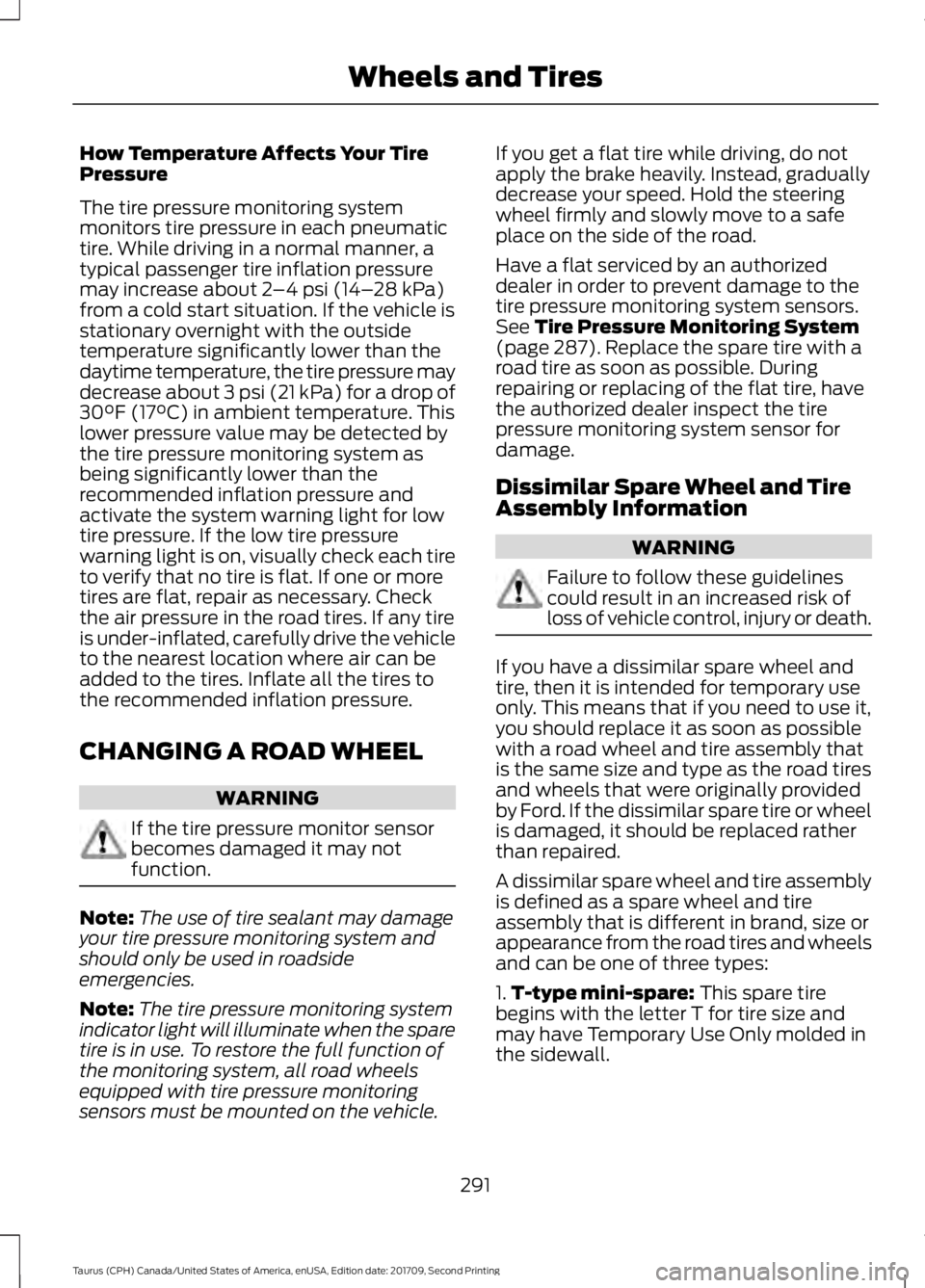
How Temperature Affects Your Tire
Pressure
The tire pressure monitoring system
monitors tire pressure in each pneumatic
tire. While driving in a normal manner, a
typical passenger tire inflation pressure
may increase about 2
–4 psi (14– 28 kPa)
from a cold start situation. If the vehicle is
stationary overnight with the outside
temperature significantly lower than the
daytime temperature, the tire pressure may
decrease about 3 psi (21 kPa) for a drop of
30°F (17°C) in ambient temperature. This
lower pressure value may be detected by
the tire pressure monitoring system as
being significantly lower than the
recommended inflation pressure and
activate the system warning light for low
tire pressure. If the low tire pressure
warning light is on, visually check each tire
to verify that no tire is flat. If one or more
tires are flat, repair as necessary. Check
the air pressure in the road tires. If any tire
is under-inflated, carefully drive the vehicle
to the nearest location where air can be
added to the tires. Inflate all the tires to
the recommended inflation pressure.
CHANGING A ROAD WHEEL WARNING
If the tire pressure monitor sensor
becomes damaged it may not
function.
Note:
The use of tire sealant may damage
your tire pressure monitoring system and
should only be used in roadside
emergencies.
Note: The tire pressure monitoring system
indicator light will illuminate when the spare
tire is in use. To restore the full function of
the monitoring system, all road wheels
equipped with tire pressure monitoring
sensors must be mounted on the vehicle. If you get a flat tire while driving, do not
apply the brake heavily. Instead, gradually
decrease your speed. Hold the steering
wheel firmly and slowly move to a safe
place on the side of the road.
Have a flat serviced by an authorized
dealer in order to prevent damage to the
tire pressure monitoring system sensors.
See
Tire Pressure Monitoring System
(page 287). Replace the spare tire with a
road tire as soon as possible. During
repairing or replacing of the flat tire, have
the authorized dealer inspect the tire
pressure monitoring system sensor for
damage.
Dissimilar Spare Wheel and Tire
Assembly Information WARNING
Failure to follow these guidelines
could result in an increased risk of
loss of vehicle control, injury or death.
If you have a dissimilar spare wheel and
tire, then it is intended for temporary use
only. This means that if you need to use it,
you should replace it as soon as possible
with a road wheel and tire assembly that
is the same size and type as the road tires
and wheels that were originally provided
by Ford. If the dissimilar spare tire or wheel
is damaged, it should be replaced rather
than repaired.
A dissimilar spare wheel and tire assembly
is defined as a spare wheel and tire
assembly that is different in brand, size or
appearance from the road tires and wheels
and can be one of three types:
1.
T-type mini-spare:
This spare tire
begins with the letter T for tire size and
may have Temporary Use Only molded in
the sidewall.
291
Taurus (CPH) Canada/United States of America, enUSA, Edition date: 201709, Second Printing Wheels and Tires
Page 451 of 510
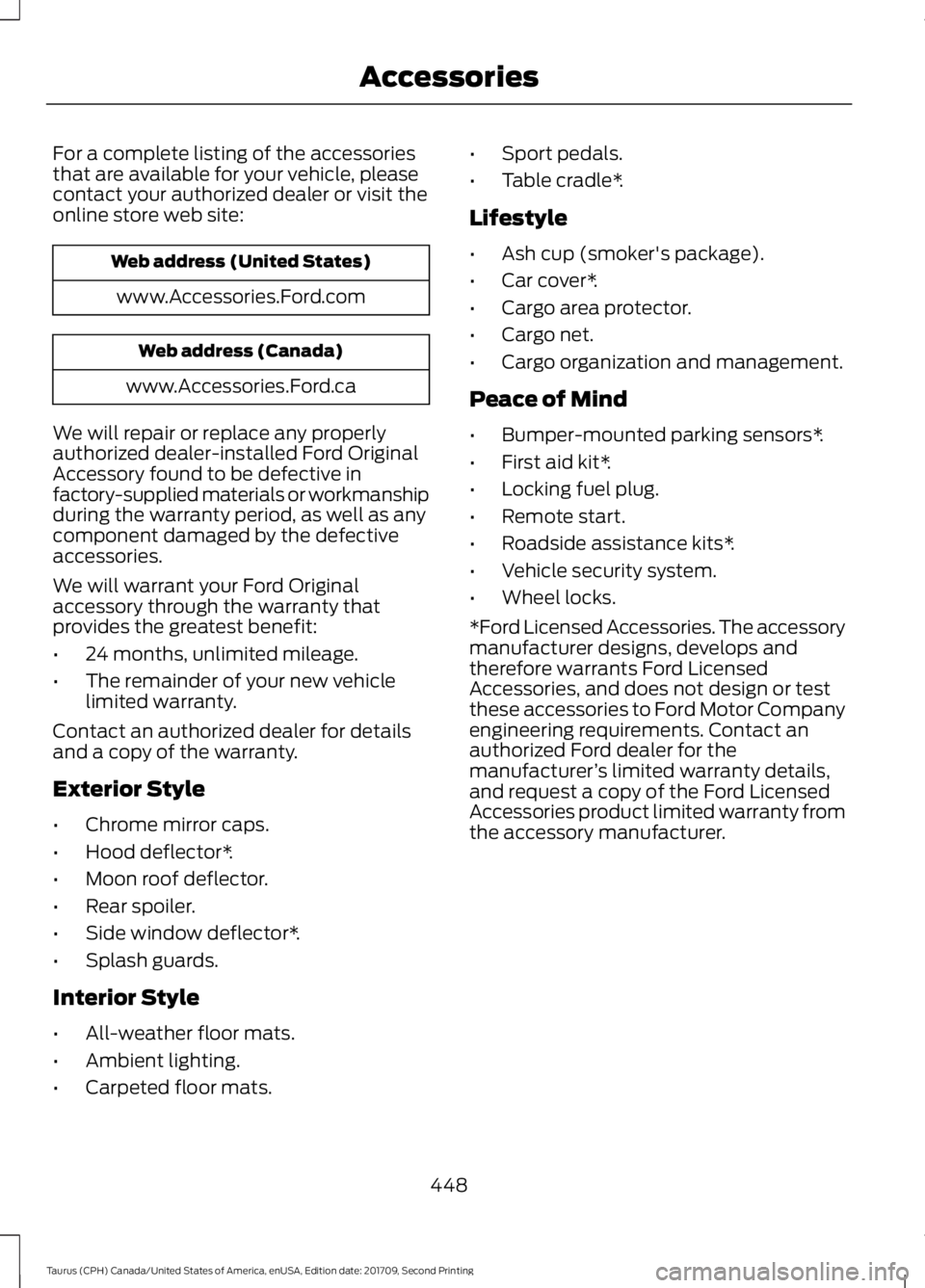
For a complete listing of the accessories
that are available for your vehicle, please
contact your authorized dealer or visit the
online store web site:
Web address (United States)
www.Accessories.Ford.com Web address (Canada)
www.Accessories.Ford.ca
We will repair or replace any properly
authorized dealer-installed Ford Original
Accessory found to be defective in
factory-supplied materials or workmanship
during the warranty period, as well as any
component damaged by the defective
accessories.
We will warrant your Ford Original
accessory through the warranty that
provides the greatest benefit:
• 24 months, unlimited mileage.
• The remainder of your new vehicle
limited warranty.
Contact an authorized dealer for details
and a copy of the warranty.
Exterior Style
• Chrome mirror caps.
• Hood deflector*.
• Moon roof deflector.
• Rear spoiler.
• Side window deflector*.
• Splash guards.
Interior Style
• All-weather floor mats.
• Ambient lighting.
• Carpeted floor mats. •
Sport pedals.
• Table cradle*.
Lifestyle
• Ash cup (smoker's package).
• Car cover*.
• Cargo area protector.
• Cargo net.
• Cargo organization and management.
Peace of Mind
• Bumper-mounted parking sensors*.
• First aid kit*.
• Locking fuel plug.
• Remote start.
• Roadside assistance kits*.
• Vehicle security system.
• Wheel locks.
*Ford Licensed Accessories. The accessory
manufacturer designs, develops and
therefore warrants Ford Licensed
Accessories, and does not design or test
these accessories to Ford Motor Company
engineering requirements. Contact an
authorized Ford dealer for the
manufacturer ’s limited warranty details,
and request a copy of the Ford Licensed
Accessories product limited warranty from
the accessory manufacturer.
448
Taurus (CPH) Canada/United States of America, enUSA, Edition date: 201709, Second Printing Accessories
Page 502 of 510
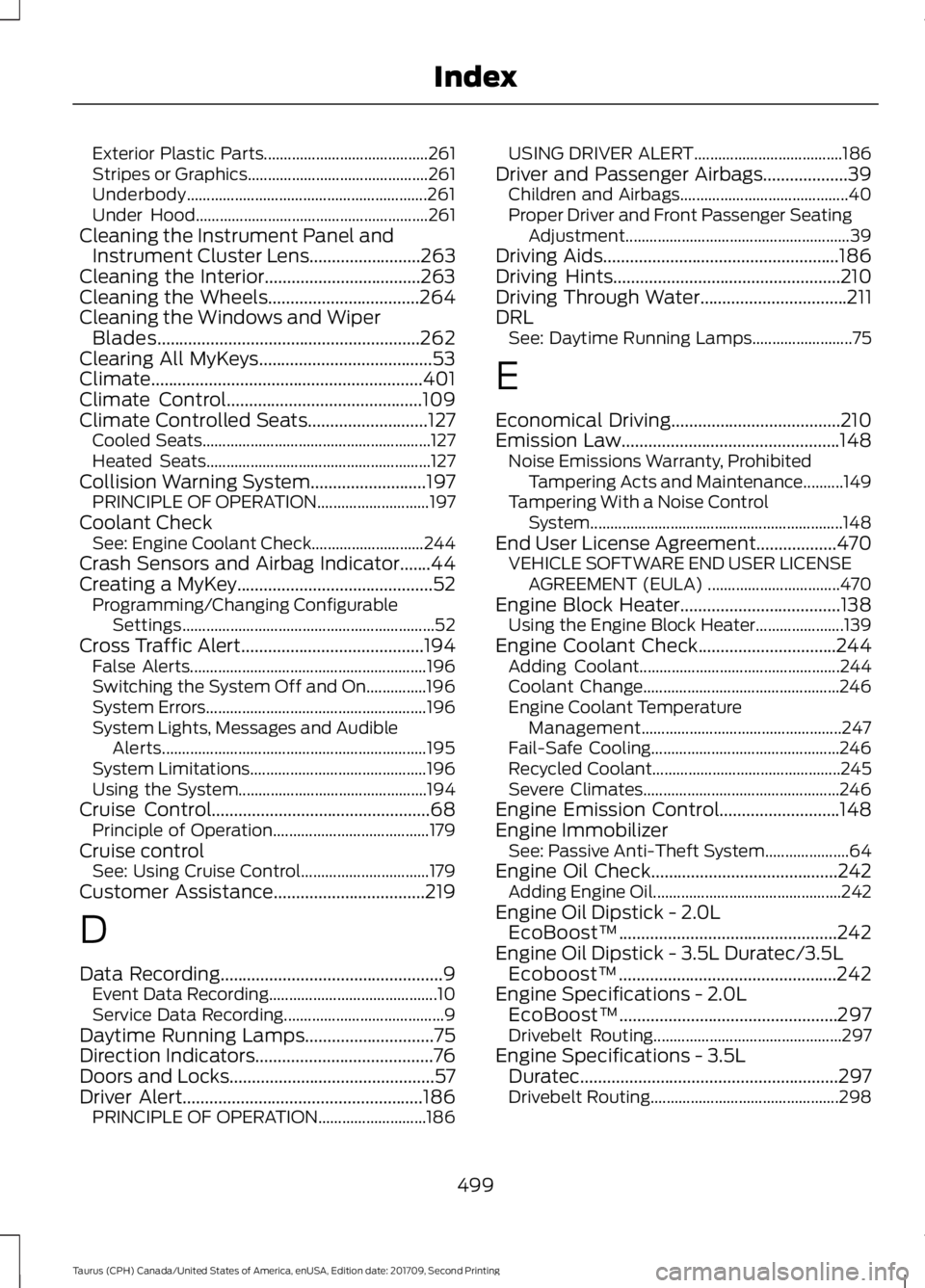
Exterior Plastic Parts.........................................
261
Stripes or Graphics............................................. 261
Underbody............................................................ 261
Under Hood.......................................................... 261
Cleaning the Instrument Panel and Instrument Cluster Lens.........................263
Cleaning the Interior...................................263
Cleaning the Wheels..................................264
Cleaning the Windows and Wiper Blades...........................................................262
Clearing All MyKeys.......................................53
Climate.............................................................401
Climate Control
............................................109
Climate Controlled Seats...........................127 Cooled Seats......................................................... 127
Heated Seats........................................................ 127
Collision Warning System..........................197 PRINCIPLE OF OPERATION............................ 197
Coolant Check See: Engine Coolant Check............................ 244
Crash Sensors and Airbag Indicator.......44
Creating a MyKey............................................52 Programming/Changing Configurable
Settings............................................................... 52
Cross Traffic Alert.........................................194 False Alerts........................................................... 196
Switching the System Off and On...............196
System Errors....................................................... 196
System Lights, Messages and Audible Alerts.................................................................. 195
System Limitations............................................ 196
Using the System............................................... 194
Cruise Control.................................................68 Principle of Operation....................................... 179
Cruise control See: Using Cruise Control................................ 179
Customer Assistance..................................219
D
Data Recording
..................................................9
Event Data Recording.......................................... 10
Service Data Recording........................................ 9
Daytime Running Lamps
.............................75
Direction Indicators........................................76
Doors and Locks..............................................57
Driver Alert
......................................................186
PRINCIPLE OF OPERATION........................... 186USING DRIVER ALERT.....................................
186
Driver and Passenger Airbags...................39 Children and Airbags.......................................... 40
Proper Driver and Front Passenger Seating Adjustment........................................................ 39
Driving Aids.....................................................186
Driving Hints...................................................210
Driving Through Water.................................211
DRL See: Daytime Running Lamps......................... 75
E
Economical Driving
......................................210
Emission Law.................................................148 Noise Emissions Warranty, Prohibited
Tampering Acts and Maintenance..........149
Tampering With a Noise Control System............................................................... 148
End User License Agreement..................470 VEHICLE SOFTWARE END USER LICENSE
AGREEMENT (EULA) ................................. 470
Engine Block Heater....................................138 Using the Engine Block Heater...................... 139
Engine Coolant Check...............................244 Adding Coolant.................................................. 244
Coolant Change................................................. 246
Engine Coolant Temperature Management.................................................. 247
Fail-Safe Cooling............................................... 246
Recycled Coolant............................................... 245
Severe Climates................................................. 246
Engine Emission Control...........................148
Engine Immobilizer See: Passive Anti-Theft System..................... 64
Engine Oil Check..........................................242 Adding Engine Oil............................................... 242
Engine Oil Dipstick - 2.0L EcoBoost™.................................................242
Engine Oil Dipstick - 3.5L Duratec/3.5L Ecoboost™.................................................242
Engine Specifications - 2.0L EcoBoost™.................................................297
Drivebelt Routing............................................... 297
Engine Specifications - 3.5L Duratec..........................................................297
Drivebelt Routing............................................... 298
499
Taurus (CPH) Canada/United States of America, enUSA, Edition date: 201709, Second Printing Index
Page 508 of 510
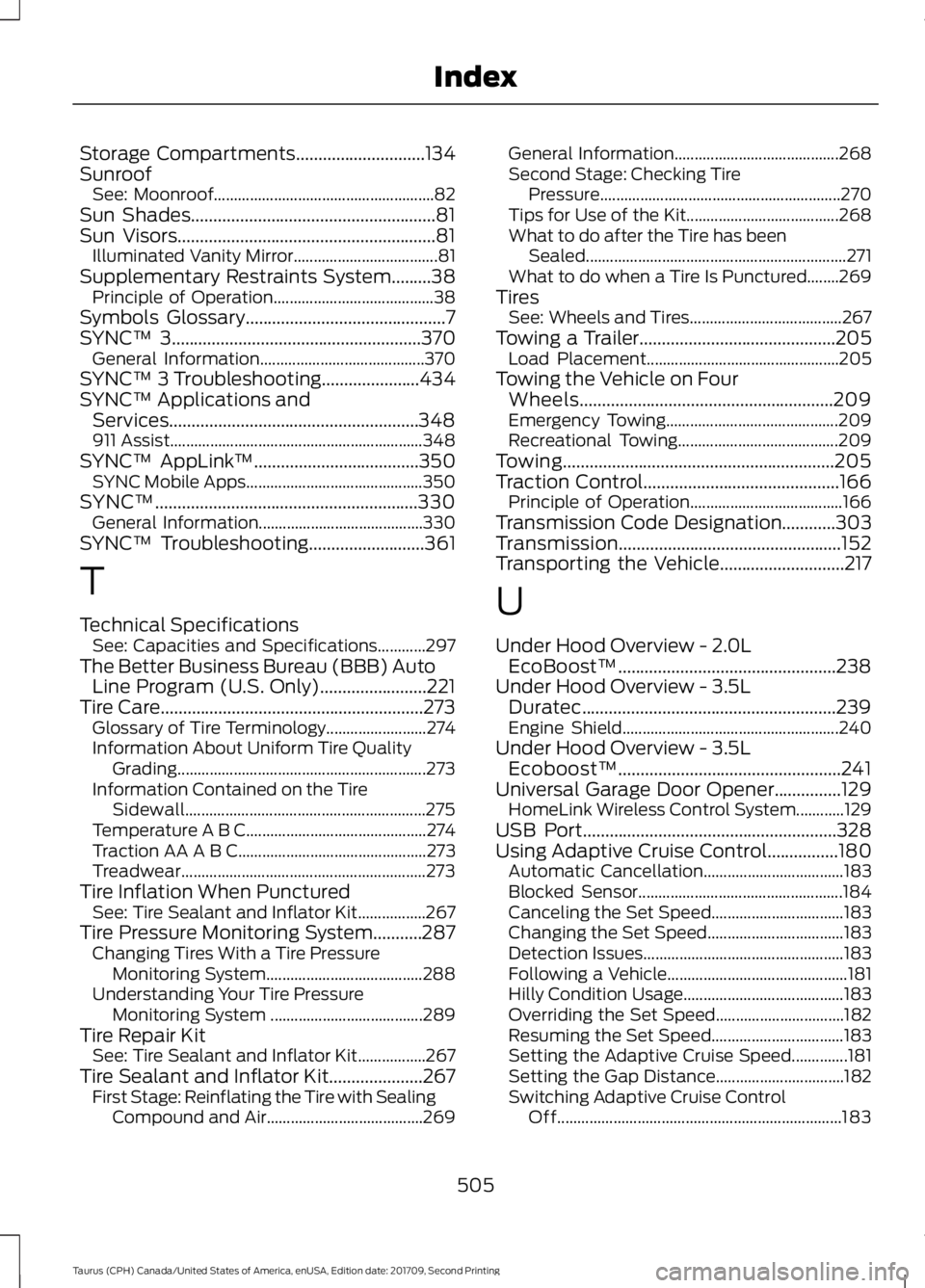
Storage Compartments.............................134
Sunroof See: Moonroof....................................................... 82
Sun Shades.......................................................81
Sun Visors..........................................................81 Illuminated Vanity Mirror.................................... 81
Supplementary Restraints System.........38 Principle of Operation........................................ 38
Symbols Glossary
.............................................7
SYNC™ 3........................................................370 General Information......................................... 370
SYNC™ 3 Troubleshooting......................434
SYNC™ Applications and Services........................................................348
911 Assist............................................................... 348
SYNC™ AppLink ™
.....................................350
SYNC Mobile Apps............................................ 350
SYNC™
...........................................................330
General Information......................................... 330
SYNC™ Troubleshooting
..........................361
T
Technical Specifications See: Capacities and Specifications............297
The Better Business Bureau (BBB) Auto Line Program (U.S. Only)........................221
Tire Care...........................................................273 Glossary of Tire Terminology......................... 274
Information About Uniform Tire Quality Grading.............................................................. 273
Information Contained on the Tire Sidewall............................................................ 275
Temperature A B C............................................. 274
Traction AA A B C............................................... 273
Treadwear............................................................. 273
Tire Inflation When Punctured See: Tire Sealant and Inflator Kit.................267
Tire Pressure Monitoring System...........287 Changing Tires With a Tire Pressure
Monitoring System....................................... 288
Understanding Your Tire Pressure Monitoring System ...................................... 289
Tire Repair Kit See: Tire Sealant and Inflator Kit.................267
Tire Sealant and Inflator Kit.....................267 First Stage: Reinflating the Tire with Sealing
Compound and Air....................................... 269General Information.........................................
268
Second Stage: Checking Tire Pressure............................................................ 270
Tips for Use of the Kit...................................... 268
What to do after the Tire has been Sealed................................................................. 271
What to do when a Tire Is Punctured........269
Tires See: Wheels and Tires...................................... 267
Towing a Trailer............................................205 Load Placement................................................ 205
Towing the Vehicle on Four Wheels.........................................................209
Emergency Towing........................................... 209
Recreational Towing........................................ 209
Towing.............................................................205
Traction Control
............................................166
Principle of Operation...................................... 166
Transmission Code Designation............303
Transmission..................................................152
Transporting the Vehicle
............................217
U
Under Hood Overview - 2.0L EcoBoost™.................................................238
Under Hood Overview - 3.5L Duratec.........................................................239
Engine Shield...................................................... 240
Under Hood Overview - 3.5L Ecoboost™..................................................241
Universal Garage Door Opener...............129 HomeLink Wireless Control System............129
USB Port
.........................................................328
Using Adaptive Cruise Control................180 Automatic Cancellation................................... 183
Blocked Sensor................................................... 184
Canceling the Set Speed................................. 183
Changing the Set Speed.................................. 183
Detection Issues.................................................. 183
Following a Vehicle............................................. 181
Hilly Condition Usage........................................ 183
Overriding the Set Speed................................ 182
Resuming the Set Speed................................. 183
Setting the Adaptive Cruise Speed..............181
Setting the Gap Distance................................ 182
Switching Adaptive Cruise Control Off....................................................................... 183
505
Taurus (CPH) Canada/United States of America, enUSA, Edition date: 201709, Second Printing Index